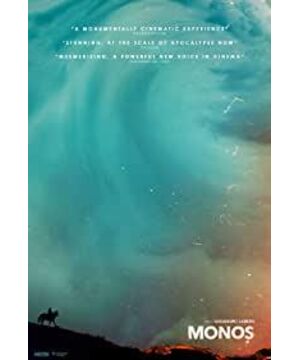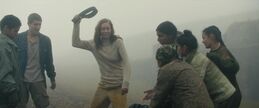[Berlin Film Festival viewing] This is the most surprising work I have seen at this film festival. There are not many Colombian movies I have seen in my impression, nothing more than an inaccessible desert or jungle background, and a folk ritual full of exotic colors. Of course, these elements can be found in this film, but it does not mean that this is an "artistic film" that uses the spectacle of third world images as a gimmick to please Western audiences; on the contrary, it is a human nature with multiple interpretation possibilities fable.
The protagonist of the film is a group of isolated teenage guerrillas who learn fighting techniques and weapon use under the strict guidance of a dwarf instructor who leaves them with the task of taking care of a cow and a English-speaking woman hostage. The episode progresses through odd rituals and mountain environments, and after the cow is shot, the plot takes a wild and unpredictable course.
From the ambiguous time background (although the climax is pointed out by a line explaining the identity of the female hostage), the film seems to portray a war between good and evil. The teenage guerrillas kidnapped the female engineer, and after the guerrilla leader committed suicide, the successor seized power and acted recklessly, and the small anarchic group was divided; one of the members, tired of violence and unwilling to obey, fled into the forest. The family originally thought that it would take this to stay away from disputes, but they continued to be chased by other members, and finally staged a tenacious confrontation with nine deaths and one death, and returned to modern civilized society after escaping. This series of tangled, indistinguishable chaotic descriptions seem to be a microcosm of the Colombian civil war of the past few decades, and the director's on-site commentary after the screening also confirms this.
However, the focus of the director's expression is not entirely to let the audience watch the chaotic history of the Colombian Civil War, because his handling of the blurring of time and space is ingenious, bringing an extremely mysterious atmosphere to the film, and it is difficult for people to guess the time and geography of the story. Location. Without seeing the enemy's war, misty mountains, and dangerous forests, the film has created a rich possibility of interpretation.
In the process of practicing martial arts and receiving discipline training, this group of isolated teenagers gradually formed a close and mutual aid, family-like organization. Each person has a clear division of labor. There is a clear definition. And when the accident happened, it fell into a state of leaderless first, and soon a domineering member took power, but it also planted the seeds for its cruel and violent means, causing the members to become bored and flee. From this perspective, the film seems to insinuate the entire process of a dictatorship country from its formation to its prosperity, and then to the disintegration of the masses due to the tyranny of the leader.
In this process, there are two important factors that lead to the contradiction and division of the "family": the rebellious psychology of adolescence and the influence of outsiders. This group of teenagers looks like they are all underage children, and their inexperienced characteristics are written on their faces and characters. The instructors instilled in them the principles of strict self-discipline and obedience to the command, and on the other hand, they also planted a psychological resistance to authority and order. After the instructors left, their repression of love and desire was gradually released, causing uncontrolled violence and disorder. The description of killing the instructor and cutting off contact with the outside world also confirms the natural nature of youth to resist authority. The script places the teenagers in this special story background, which has a very intriguing effect.
This approach has deep roots in the classic "Lord of the Flies". The same naive and ignorant teenager gradually degenerated into an animal-like barbarian and a violent maniac, revealing the darkness and animal nature of human nature, just like the double-referential meaning of the title "Monkey". However, different from "Lord of the Flies" and subsequent films with similar themes, such as last year's French film "Wild Boys", this film is not confined to a fixed environment to tell the evolution of human nature, but uses a changing space to show The process of degeneration of human nature is another ingenious move of the director. The psychological and behavioral changes of adolescents have formed an implied correspondence with the natural environment in which they live. From mist-shrouded mountains to crisis-ridden jungles, they have transformed from isolated, helpless and tightly-knit organizations to disoriented and far away. The "monkey" of civilization.
What the director further complicates this model, which is derived from the classic narrative, is the addition of an outsider's perspective, the important role of the female hostage. At first, the hostage did not get along with them too badly, and might even act as a "mother" in the organization. In her eyes, they were all just children, and the absurd things they did were not what they really thought. However, as an adult, she obviously knows more, and her language and ability to deal with crises, as well as her alertness, are better than those of these child soldiers. She escapes once, is captured, and then uses the sympathy and innocence of her caregiver to free herself, showing a stark contrast between adults and teenagers. The script's portrayal of her, and the actress's portrayal of the dark and complex side of human nature, is brilliant.
The film's visual style is unforgettable, with camera movements and mise-en-scène maintaining a precise fit with the gripping script, from mountains to jungles to rapids, reflecting the creator's careful design. But what stands out the most is the sound and soundtrack. Mica Levi, who once composed the soundtrack for "Under the Skin", still produced a sensational and shocking effect this time. The drum sound simulating thunder appeared on the screen from time to time, rendering a strange and compelling atmosphere, suggesting that the plot was moving in an elusive direction. The development is exactly the same as the human nature portrayed in the script.
First released on the movie public account, the movie tactile CineTouch
View more about Monos reviews









